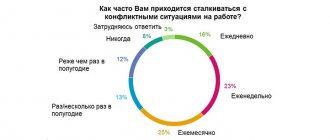Conflict situations occur not only between individuals.
Much more serious conflicts arise when entire states and millions of people are involved in the incident.
Many people do not fully understand what the danger of interethnic conflicts , how important it is to solve the problem peacefully, otherwise serious consequences are possible.
How to resolve internal conflict? Expert advice to help you!
Concept
A national conflict is a clash of interests and views between national-ethnic communities or their components.
In most cases this is the result of nationalism.
Interethnic conflict is a broader concept. This is a type of social conflict. There are many contradictions at its core.
Usually they are of a state, political, ethnosocial nature. Thousands and millions of people take part in such disputes. They are widespread and can last for years, decades.
If the parties stop hearing each other and try to prove that they are right, the situation becomes very complicated and can lead to military action .
That is why they try to solve such situations in the first stages, preventing their development.
https://youtu.be/xHGLVZFVFFg
Types of peaceful existence
- Ethnic mixing
- interethnic marriages contribute to the mixing of different ethnic groups, which after some time and generations form a single nation. - Ethnic assimilation
is the absorption of one people by another. They separate civilian and military uniforms. - The formation of a multinational state
is a state in which nations are given complete freedom and rights. In some countries, several languages are assigned at the state level.
What are the causes?
Why do they arise? The causes of national and interethnic conflicts are slightly different. The first group includes the following factors:
- Ethnopsychological . Destruction of the usual way of cultural life, fear of losing established national values, rejection of new norms.
- Political . Different political leaders can have a certain influence on national communities, and this influence is not always positive. The impact can be very negative. There are cases in history when peoples were persecuted and discriminated against due to certain political actions.
- Socio-economic. If a certain ethnic society is criticized by society, its rights are infringed, this also affects the economic component of individuals. This infringement can lead to conflict.
- Cultural .
Conflicts occur due to cultural differences between certain ethnic groups that cannot accept the existence of these differences. Criticism and discrimination are an integral part of such a situation. Peoples cease to understand and hear each other; they try to prove that one ethnic group is better than another. Claims to cultural and traditional features are indicated, to which the opposition reacts especially emotionally.
The causes of interethnic conflicts include other factors:
- Geographical Disconformity .
Peoples are not happy with the establishment of territorial boundaries; the belonging of a territory to one or another ethnic group may be disputed. The situation becomes especially complicated if one territory once belonged to the first party, and after a certain time to the second. Then both peoples have the same rights and the fate of the territory becomes uncertain. - Social dissatisfaction . It can manifest itself both within one state and several at once.
- Story . In the past, there may have been contradictions and misunderstandings between certain peoples. Some issues may concern ethnic groups in the present, causing conflicts.
- Cultural and linguistic claims . Most often they happen due to the suppression of culture, the prohibition of a certain language.
- Natural resources . Different peoples can fight and war for them.
- Difference of religions . Commitment to one faith or another can become a real cause for conflict. A people can adhere to one religion and criticize another, imposing their views on their opponents.
↑ Causes of interethnic (international) conflicts
- state rivalry;
- tensions between ethnic majorities and ethnic minorities;
- divergence of national interests;
- territorial disputes, discrepancy between state or administrative borders and the boundaries of settlement of peoples
- inequality in living standards, different representation of ethnic groups in prestigious professions, social strata, government bodies
- uneven distribution of natural resources in the world;
- insufficient, from the point of view of the ethnic minority, use of its language and culture in public life)
- historical (historically established tradition: wars in the past, former relationships of domination and subordination, etc.)
- belonging to different religions and confessions, differences in the level of modern religiosity of the population
- discrimination - restriction of rights, deprivation of equality of any state or population group, etc.
The cause of interethnic conflicts can also be any thoughtless or provocative statements by politicians, national leaders, representatives of the clergy, the media, or domestic incidents.
Types and examples of modern conflicts
There are national conflicts:
- Interethnic . This is a misunderstanding that occurs between representatives of ethnic communities. They live close to each other, in the same state.
- Ethno-confessional . Confessional differences aggravate ethnic ones, complicating the situation. It is clearly manifested in regions where several peoples live, each of which developed in a specific civilization.
- Ethnopolitical . Misunderstandings and clashes of views are associated with the politicization of an ethnic community.
- Ethnoconflict . This is a clash of views between representatives of different ethnic groups. Usually, contradictions are associated with the cultural characteristics of peoples and traditions.
A striking example is the dispute between Armenia and Azerbaijan over who owns Nagorno-Karabakh.
The territory has a rather interesting history and is of great importance for both states, so it has not been possible to resolve the dispute for many years .
Types of interethnic conflicts include:
- Conflicts of stereotypes . Ethnic groups do not understand the causes of contradictions, do not remember the true sources of disagreements, but people retain a negative image of this or that people.
- A clash of ideas. An ethnic group puts forward a certain proposal that is not supported by other ethnic groups and is even condemned.
- Misunderstandings based on certain actions . They are rallies, demonstrations, open expression of certain claims. Such measures can cause negative attitudes, criticism, and misunderstandings.
Interethnic conflicts in history are very common.
This is a struggle for resources, for territory .
An example is the Chechen conflict, when the issue of independence of Chechnya .
There were supporters of Chechnya's secession from Russia and supporters of its preservation within the country. Then different ethnic groups tried to prove that they were right, the need for independence, which is why the conflict occurred.
Read about ways to resolve intergroup conflicts here.
Local national and religious conflicts in the former USSR in the 1990s:
↑ International (interethnic) conflict
Interethnic (ethnosocial) conflicts
are one of the forms of relations between national communities, characterized by a state of mutual claims, open opposition of ethnic groups, peoples and nations to each other, which tends to increase contradictions up to armed clashes, open wars.
International conflict
- an open political clash between two or more states based on the discrepancy or contradiction of their interests.
The main cause of conflicts between representatives of different nationalities is ethnocentrism - a set of prejudices of one nation towards another, confidence in the correctness of one’s own culture, a tendency to reject the standards of another culture as incorrect, low, unaesthetic.
Ways to overcome and solutions
What is the conflict resolution plan? To overcome conflicts and resolve such situations, you need to hear each other. Negotiations and the conclusion of peace treaties are used.
Diplomats participate in negotiations and offer compromise solutions.
If the parties hear each other and respect opposition views, such situations will be resolved.
Experts believe that such situations must be stopped at an early stage in order to prevent war and loss of life.
It is necessary to prevent discrimination against the population , the infringement of this or that people, it is necessary to cultivate in citizens respect and love for other cultures, the desire to get to know each other, and not to show hatred.
Unity, the desire to understand each other, these are the components that help effectively prevent conflicts. Respect for each other's interests will help maintain peace .
Interethnic conflicts and ways to overcome:
On the reasons for the aggravation of national issues
Sergey
,
50 years old, Bendery, former Deputy Minister of Foreign Affairs of the PMR
The authorities of Chisinau added fuel to the fire by choosing terror tactics against the young Transnistrian Moldavian Republic, which advocated the preservation of the USSR, which could guarantee security, rights and freedoms to the population. There was only one desire - if only the situation on the Dniester did not repeat the fate of Nagorno-Karabakh and other hot spots on the territory of the Soviet Union. On the other hand, there was a fear that bloodshed could not be avoided. Moreover, after the collapse of the USSR, the hands of the Moldovan government were completely untied.
Moldovan nationalist reformers immediately chose the tactic of building a mononational state, not Moldavian, but Romanian, with subsequent unification with Romania.
The cause of the conflict lies in the actions of the elite, which chose the winning option of raising national consciousness. In a deep crisis, this is a win-win option. In addition, these same elites, having replaced the communist ideology with a nationalist one, had the prospect of becoming the head of an independent state. Apparently, in order to achieve their goals, such elites were ready to go even through the blood of their own citizens
Paul
,
59 years old, Tiraspol, pensioner
I remember there were rallies and strikes when the language law was discussed in Moldova. We demanded bilingualism. Moldovan was considered the official language, and then they changed it into Romanian. Then workers came from the Baltic states, and they spoke out and said: “Don’t believe them. Just like us, you will be cheated of your citizenship!”
This has always been Russian land. And here was the Russian world. The majority of the population here was Russian. My grandfather, born in 1905, said that even during the occupation of the Romanians, they lived well with them. They persecuted the Moldovans more and did not consider them as people. My grandfathers all knew Romanian, although they were Russian citizens. They were not oppressed, they kept gardens and lived prosperously. The Moldovans got more from their Romanians.
The conflict arose on ethnic grounds. The Moldovans had such thoughts that we would separate and live like European countries. At the same time, everyone knew that Moldova was the all-Union breadbasket. And such a false impression was created that we were feeding Russia. But Russia built cities and factories here, rebuilt Chisinau, destroyed during the war, built Tiraspol, Bendery - all to the detriment of its cities.
The political strike in the Moldavian SSR took place in August-September 1989. Strikes became a form of protest against the discriminatory policies of Chisinau. Transnistrian cities and regions opposed the adoption of a package of laws on languages, which actually put other nationalities of the union republic in an unequal position with Moldovans
Photo: Igor Zenin / RIA Novosti
Evgeniya
,
85 years old, Baku-Tbilisi, pensioner
After the war, I graduated from school and studied to become an economist in the oil industry. In those days, Baku was an amazing city, people valued kindness and knew how to support. Still, the people were different... Armenians and Azerbaijanis got along well, there was a whole Armenian quarter. There was not just hostility; they were highly valued as specialists in their fields. Many Jews also lived in the city; they were the first to leave with the beginning of all the upheavals. We, thank God, did not experience the horror that began later. In 1983, my daughter went to study in Moscow, and three years later I moved to distant relatives in Tbilisi. Why? By that time, something had already changed, new management had arrived.
In the mid-1980s, negativity began to awaken towards Russians. At first it wasn’t felt much, but then they began to gradually spread rot at work. The “growth of self-awareness” began. For the locals, it was that we “occupied” them. Everyone felt very self-sufficient. They secretly said, if we just get out of here, everything will be very good. Although, of course, not everyone thought so...
But it turned out to be no easier in Georgia either. Although I have Georgian roots, I did not know the language. There was already a sense of decline and food shortages, just like in Baku. And although my relatives supported me as best they could, the negativity towards the Russians only grew. At first everything was fine, I got a job in a small office and did accounting there. But by 1989 it became clear that we had nothing to count on.
The Russians looked for an opportunity to leave, but often there was simply no opportunity. The locals urged us to do this in every possible way: “We have tangerines, we have tea, why do we need you? You have oppressed us all our lives!”
At the same time, conflicts with the Ossetians began. In Tbilisi they were economically strong, had their own houses and businesses. And when they wanted to separate, they were told: “Get out of here!” The Ossetians abandoned their homes, beautiful houses in the city center. At best, their yesterday's friends bought it for next to nothing. In the worst case, they simply left the apartments and ran away.
An angry Georgian woman at a rally against the policies of USSR President Mikhail Gorbachev in Tbilisi, April 2, 1991
Photo: Peter Andrew/AP
Soon all signs in Russian were removed in the city. They hung it in English. They stopped answering us in Russian in stores and government departments. One day they came to me at work and said that I should now conduct all documentation in Georgian. I said: “No problem, give me the courses, I’ll learn!” But they refused, saying that she had to get out on her own. And then food was already sold using coupons.
A little later, colleagues and strangers began to directly demand that I leave Georgia, although my relatives did not want to let me go. They were very decent people. The neighbors were looking at the apartment. Above us lived a large family that needed to expand. They came and said in plain text: “Sell, we like your apartment. We’ll give you some pennies for it.” And this was still the USSR! But there was nowhere to leave, I lived in great fear for about a year...
Natalia
,
Dushanbe-Volgograd, 68 years old, pensioner
I was born and raised in Dushanbe. By the end of perestroika, I trained to be a doctor and worked in an ambulance. Even then there was a severe food crisis. There were dead chickens in the stores, there were huge queues for meat, and milk could only be obtained occasionally. But they saved the fruits and vegetables that Tajikistan abounds in. Already at that time we decided to move. My ancestors are Don Cossacks. They all dreamed of returning to their homeland. My family was single-parent, we started sending little things in containers, and we ourselves lived in an empty apartment. Our friends, old Tajiks, didn’t even want to let us go. They asked: “Where are you going? Have we treated you badly?”
But since 1990, young people began to behave aggressively. There were situations where you couldn’t walk through the streets—they were shooting. My brother was once riding in a minibus and it was thrown with stones. In general, they rather conflicted with each other, we became random victims
When the revolution began, it became completely scary. For Eastern people, it is always important which region comes from a leadership position. And the contradictions between the north and south were very strong at that time. All conflicts were precisely on this basis. The north was mainly represented by democrats, the south by communists. In the center of the city, rallies of one and the other began to gather more and more often. They passed literally a few hundred meters from each other.
An armed ethno-regional conflict for power in Tajikistan followed the declaration of independence
Photo: Ratushenko / RIA Novosti
To be honest, I didn’t care, but rather my environment was for the communists. When you work in an ambulance, you know more than others. We saw a lot... And the “cargo 200” from Afghanistan, and victims on both sides, and how the Democrats were given money at rallies. Our university, by the way, was located not far from these squares. Fellow students said that they were often chased by demonstrators after classes. They insulted my Tajik friends who went without headscarves. But there were no ethnic conflicts in the working environment. Russians and Tajiks worked together.
In 1991, residents of the northern regions of the country began to actively flock to Dushanbe. This only worsened the conflicts on the streets. We were afraid of them. It was impossible to go anywhere. Many streets were under fire. But they didn’t open fire on us on purpose; stray bullets occasionally hit the apartments. By this time, even the stores had run out of bread.
One day we were going to a call, and in the middle of the road there was a huge crowd of Tajiks. They stand and pray, bow to the east, and sing warlike prayers. It was like a force of nature, beyond the control of anything. But then no one spoke out loud about the Islamic revolution. It was only about democracy. We still didn’t understand well what was happening. We thought that the radicals were there in Afghanistan, but everything turned out to be much more complicated
When these events began in 1991, I left, but soon had to return. I was sent to complete my studies as a psychiatrist. The fact is that my child was very sick at that time, we found him a clinic in Russia. When you only think about him, all other problems blur. You pay less attention to what is happening. It was terribly difficult to leave. Almost all institutions were closed, and it was impossible to sell the apartment. But one fine day I managed to find a lawyer. Within 24 hours, all the documents were completed and the housing was given to the Tajiks from the north. They treated me quite aggressively. They didn't like everything. They were very negative.
My family was able to obtain resettlement tickets, and upon arrival in Russia, through friends in the migration service, I was allocated an apartment in Volgograd. We didn’t really understand who we were back then. Russians? Soviet? There was a mess in our heads. And although I was always in demand as a doctor, almost no one helped me in everyday life. In 1992, I returned to Dushanbe. The civil war began, but somehow I quickly got used to it. By that time, almost everyone had fled from the institute. Only the Russian professor and one teacher remained. That same year, due to my son’s condition, I had to return to Russia again.
When I arrived in Moscow, for a long time I could not understand what was happening to me. My ears were blocked - I just stopped hearing shots. One day I saw a report from Tajikistan on TV and experienced horror for the first time. But when I saw the same thing with my own eyes, there was almost no fear
In these vile conflicts, I think, external forces are primarily to blame. They played on the contradictions between different regions of the republic. The North was told that democracy would soon be established in Tajikistan, but it turned out exactly the opposite.
Novel
,
29 years old, Tashkent-Moscow, journalist
Tashkent is a city where Soviet remnants were preserved until recently. Growing up, I felt like I was living in the Soviet Union. I saw a time when the Uzbek language was actively translated into Latin, and Russian began to be replaced everywhere. But Tashkent was still a multicultural city. Already in the mid-1990s, Russians began to be fired everywhere. When I arrived at school, the students were divided into Russian and Uzbek shifts. This gave rise to great conflicts.
Soviet Tashkent
Photo: THIERRY ORBAN/Sygma/Getty Images
There has always been a division among students, but not along ethnic lines, but according to language - Russian-speaking and Uzbek-speaking. Obviously, I hung out with the first ones. But we lived in the city center, the area was considered prosperous, and it never came to open clashes. Most of them were Russians. Perhaps things were different on the outskirts of the city.
By this time, almost the entire intelligentsia left Uzbekistan - engineers, teachers, doctors. People from villages with low qualifications came to take their place. They were generally angry with everyone.
Residents of the outback often stirred up the national question and humiliated their Russian-speaking compatriots. There was also pressure from above. The state tried to squeeze Russian culture out of all spheres of public life, and nationalists were simply not stopped from squeezing out their rights
Ways to resolve social conflict
A conflict is a clash between two subjects or social communities due to the desire to possess something that is equally valuable to both parties.
The subjects of the conflict process are the participants in the confrontation, among whom there are instigators, witnesses, accomplices and mediators. Individuals who observe a confrontation situation from the outside are called witnesses. Instigators are subjects who push other individual participants to confrontation. Accomplices are persons who contribute to the escalation of the conflict with the help of advice, recommendations, and technical means. Mediators are people who try to prevent, stop or resolve a conflict situation.
You need to understand that not all persons participating in the conflict are in confrontation with each other. In addition, for the development of a conflict situation, a reason and a reason are necessary, as well as the presence of a subject of confrontation.
The benefit or issue that provoked the emergence of confrontation is the subject of conflict. Its causes are objective conditions, events that predetermine the emergence of a conflict. The cause of the conflict always has a relationship with the needs of the warring parties.
The reason for the emergence of a conflict situation may be a minor episode that contributes to its occurrence. At the same time, the situation of confrontation may not transform into a conflict.
To understand the causes and ways of resolving conflicts, it is necessary to distinguish between contradiction and conflict. A contradiction is a fundamental disagreement in important ethnic, political and economic interests. It is the foundation of any conflict process and is found in a feeling of dissatisfaction with the current state of affairs and the desire to change it. The contradiction does not necessarily develop into open confrontation. In other words, contradiction expresses an invisible and static factor of the situation, and conflict is mobile and open.
Social conflict is the highest degree of escalation of contradictions in the structure of relationships between individuals, social groups, institutions, and society as a whole and is characterized by the multiplication of opposing views, interests of individual subjects and communities.
The cause of the conflict is always interconnected with the needs of the participants in the confrontation. The following reasons provoking social conflicts are identified:
- social heterogeneity of society, the presence of opposing life guidelines and views;
— differences in social status, income level, culture, education, access to information;
- differences of a religious nature;
— behavior of individuals, their socio-psychological characteristics (temperament, intelligence).
Basic ways to resolve conflicts. In order to skillfully manage conflicts and competently use ways to resolve conflicts in a team, it is necessary to know the stages that a social conflict goes through as it develops. There are three main stages, namely pre-conflict, conflict and the stage of conflict resolution. At the pre-conflict stage, participants realize the presence of emotional tension, try to overcome it, strive to understand the causes of the conflict, evaluate their own capabilities, and also choose a method of influencing the opposing side.
The conflict stage is the conflict itself. It is characterized by a lack of respect and the presence of mistrust towards the enemy. At this stage, agreement is impossible. The conflict stage is impossible without a reason or incident, that is, without social actions aimed at transforming the behavior of the warring parties. This stage also covers open and covert actions of opponents.
The conflict resolution stage marks the end of the incident, that is, the elimination of the factors that provoked the clash.
Experts identify the following ways to resolve conflicts in a team:
- solving the problem with the help of mutual concessions of the participating individuals, that is, the parties preferred a compromise;
- peaceful conversation between rivals to resolve the problem - negotiations;
- turning to a third party to resolve the conflict in absentia - mediation;
- seeking help in resolving the confrontation from an authority vested with special powers (arbitration or arbitration);
- unilateral use of power or position by the participant who considers himself stronger, is higher on the social ladder or service hierarchy.
Social, ethnosocial conflicts and ways to resolve them are as follows: restoration, waiting (non-interference), renewal.
Restoration represents the return of the community to the pre-conflict stage, that is, to the previous structure of social life, social institutions, which, taking into account new circumstances, continue to exist.
Waiting (non-interference) is the expectation that everything will work out without intervention, that is, by itself. This “strategy” follows the path of delaying and various reformist delays, shifting on the spot. If the confrontation does not threaten general failure, then in an open society, the described strategy of behavior can be fruitful under certain conditions.
Renewal is an active way out of the conflict process through discarding, renouncing the old and developing a new one.
Any social conflict is characterized by specificity and course in certain social circumstances. Therefore, psychology argues that the ways to resolve conflicts must correspond to the current situation.
And a global strategy for exiting collective confrontation should cover and combine the main ways of resolving conflicts listed above. The key to resolving any conflict situation is renewal. However, it is impossible to update absolutely everything due to the inertia of human consciousness. Therefore, it is necessary to prepare for the natural reaction of individuals - a rollback to a number of previous forms of being and values.
What is ethnic conflict?
Clashes based on national contradictions are called ethnic. They can be local, at the everyday level, when individual people conflict within the same locality. They are also divided into global ones. An example of ethnic conflict at the global level is Kosovo, Palestinian, Kurdish and the like.










